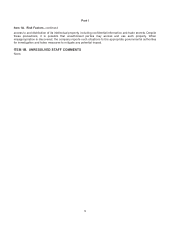DuPont 2008 Annual Report Download - page 20
Download and view the complete annual report
Please find page 20 of the 2008 DuPont annual report below. You can navigate through the pages in the report by either clicking on the pages listed below, or by using the keyword search tool below to find specific information within the annual report.
ITEM 7. MANAGEMENT’S DISCUSSION AND ANALYSIS OF FINANCIAL CONDITION AND
RESULTS OF OPERATIONS
CAUTIONARY STATEMENTS ABOUT FORWARD-LOOKING STATEMENTS
This report contains forward-looking statements which may be identified by their use of words like “plans,” “expects,”
“will,” “anticipates,” “intends,” “projects,” “estimates” or other words of similar meaning. All statements that address
expectations or projections about the future, including statements about the company’s strategy for growth, product
development, market position, expenditures and financial results are forward-looking statements.
Forward-looking statements are based on certain assumptions and expectations of future events. The company
cannot guarantee that these assumptions and expectations are accurate or will be realized. For some of the
important factors that could cause the company’s actual results to differ materially from those projected in any such
forward-looking statements see the Risk Factors discussion set forth under Part I, Item 1A beginning on page 6.
Overview
Long-term Growth Strategies – DuPont strives to grow shareholder value over the long term by executing its three
growth strategies – Putting Science to Work, Leveraging the Power of One DuPont and Going Where the Growth Is.
DuPont science and innovation is focused on delivering solutions for some of the world’s toughest challenges such
as the need for increased food production, renewable energy and raw materials, energy efficiency, and greater
safety and protection. The initiatives employed to achieve the strategies are: #1 Grow in the areas of agriculture,
biosciences, safety and protection and polymer science by delivering science-based solutions. #2 Expand the
company’s position in emerging markets. #3 Extend cost and capital productivity gains. Over the long term, DuPont
continues to see the potential for attractive earnings growth from these initiatives. In addition to its growth strategies,
DuPont’s financial discipline principles are critical to delivering shareholder value over time. The principles are first to
maintain a strong balance sheet and second to return excess cash to shareholders unless there is a compelling
opportunity to invest for growth. The company’s strong balance sheet supports liquidity and a low cost of borrowing
and is a direct result from the disciplined execution of these principles.
Global Economic Conditions – The year 2008 was challenging due to a global economic recession with demand
weakness in North American and Western European motor vehicle and construction related markets and dramatic
escalation of global raw material, energy and transportation costs. Despite these challenges, the company delivered
4 percent sales growth and strong performances from the Agriculture & Nutrition segment, Pharmaceuticals, and
most businesses in emerging markets. Early in the fourth quarter 2008 a financial crisis spreading globally triggered
unprecedented market volatility and depressed economic growth. The fourth quarter of 2008 was the clear pivot
point in the economic environment with a steep decline in demand becoming pervasive across a broader range of
end markets and geographies. Reflecting these conditions, the company’s full year sales volume dropped 5 percent
versus the prior year.
Response to Challenging Global Market Conditions – In December 2008, DuPont announced plans to address
rapidly deteriorating market conditions and strengthen the company’s future competitiveness. Plans are focused on
generating cash by better aligning cost, working capital and property, plant and equipment expenditures to the
revised demand signals of the fourth quarter. These plans include a restructuring program with an associated fourth
quarter pre-tax charge of $535 million, with expected pre-tax savings of about $130 million for 2009, and about
$250 million annual savings thereafter. The restructuring will reduce about 2,500 employee positions, primarily those
associated with motor vehicle and construction related businesses in Western Europe and the U.S. In addition to the
expected $130 million cost savings in 2009 from restructuring, the company detailed plans to deliver an additional
$600 million cost reduction in 2009. These plans include fixed cost productivity improvements, as well as immediate
cost reductions implemented across the company such as significantly reducing discretionary spending, temporarily
idling over 100 sites, reducing about 4,000 contractors and continuing productivity projects for streamlining and
leveraging opportunities across operations, supply chain and support functions. The company also outlined 2009
plans to achieve a $1 billion net working capital reduction, and a 10 to 20 percent reduction in capital spending.
18
Part II
























